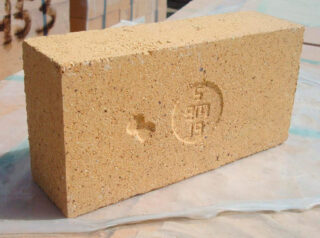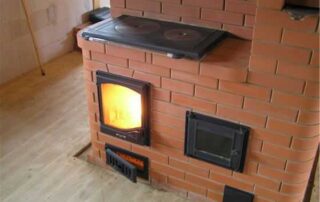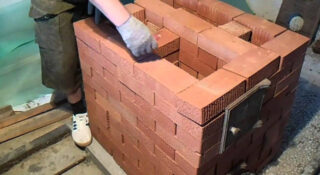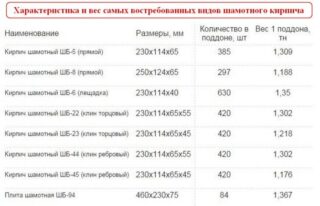When burning wood in a fireplace, the temperature in the combustion chamber reaches + 1200 ° C, and even more when using coal. When choosing a brick you need for laying a stove in a house, you should take into account the thermal and strength load that will affect it. To make the right choice, you need to study the range of available material, its features and rules of use.
Types of oven bricks

Requirements for bricks for laying furnaces are described in GOST 390-2018.
In accordance with the provision of the document, it is allowed to use products of this type:
- Basic (lime-magnesia). It is made using magnesite, due to which it has a melting point of + 2000 ° C. More used in industrial production.
- Fireclay (aluminous). Consists of a special type of clay - chamotte. It has a high resistance to heat, a faded look, therefore it only goes to the arrangement of fireboxes and channels.
- Clinker. The blocks are made from high temperature hardened clinker clay to form a ceramic layer that protects the surface. The material is versatile, but it also costs more.
- Quartz. It is a mixture of sand and a small amount of pottery clay. During firing, a solid product with melted edges is formed. Reacts negatively to substances formed after mixing condensate and soot.
- Carbonaceous. Graphite and coke are added to the clay mixture. The finished material is characterized by high strength, heat resistance and resistance to chemically active substances.
When deciding which oven brick is best to use for the oven, you can dwell on the used one. The presence of surface cracks is allowed on it. It is not allowed to use burnt, silicate, decorative and building materials for the construction of the stove.

A brick oven has been made for decades, so the choice of material must be approached competently and responsibly. Each of its types has certain features and prices. To reduce costs, the hearth is laid in sections.
Calculating how much brick is needed for a stove for a house with a stove, the amount for the firebox, chimney and body is determined separately. Knowing the size of the kiln brick, the number of stones in the order is added. In this case, it is taken into account that the size of the firebox with the same dimensions of the body can differ significantly. If a Swede has an oven, a water circuit of a five-revolution or three-revolution is installed, more fireclay blocks will go to it. When a Dutch woman is made with a stove bench, the consumption of red bricks will increase.
As a rule, fireclay grades are used for the brazier, the body is laid out of red, and the chimney is made of clinker bricks.
Comparative characteristics of red and fireclay bricks
The dimensions of the red brick for the oven are 120x250x65 mm. Types:
- Standard. Serves for laying out walls, loungers and chimneys. Frost resistance F 50, moisture absorption 8-10%, thermal conductivity 0.51 W / (mK), voidness up to 13%.
- Refractory. Designed for high temperatures up to + 1750 ° С. Thermal conductivity from 0.70–0.85 W / (mK), voidness from 8%, moisture absorption 8%.
- Zabutovochny double. Used for walls, which is useful for speeding up construction.Frost resistance F 150, moisture absorption 10%, thermal conductivity 0.50 W / (mK), voidness up to 13%.
- Ceramic. It is used for laying the foundation and the base of a brick hearth. Frost resistance F 50-100, moisture absorption 6-16%, thermal conductivity from 0.70 W / (mK), voidness 13%.
- Basement. Frost resistance F 100, moisture absorption 12%, thermal conductivity 0.51 W / (mK), voidness less than 13%.
The weight of the red oven brick is 3.4-3.6 kg, the double model is 6.9-7.2 kg.
Fireclay blocks are classified according to the following classes:
- SHA. They are used for the formation of furnaces, designed for a temperature of + 1800 ° C.
- SB. A versatile, relatively inexpensive material that can withstand heating up to + 1600 ° C, which is quite enough for a household device.
- SHL. A lightweight version, in demand during construction without a heavy foundation. The fire resistance level is + 1500 ° C.
When designing a hearth, you can choose shortened and elongated blocks, shaped, large, special and complex. This will facilitate laying and reduce additional fitting work.
Determination of quality and calculation of the quantity of bricks

When buying a material, you need to carefully check its quality. The most important thing is integrity and strength. A good block can withstand a strong hammer blow while producing a ringing, high-pitched sound. One of the fragments should be split - inside it should be of a uniform color, and the chip should be even. Grooves and irregularities in the surface are the result of the technological process and are not considered a defect.
Blocks are counted in order. There is simply no other way to get an accurate result. The furnace is a hollow structure, the demand is calculated in pieces, which are then converted into cubic meters. It is in such units that the products are released and shipped.
Since different types of stones will be used in construction, their number should be calculated in the following areas:
- base;
- walls;
- facing layer;
- channels;
- chimney;
- furnaces;
- decorative elements.
If a block is to be cut, it is considered as a whole.
Since chamotte better retains thermal energy, it is advisable to overpay a little and use it for the construction of the entire structure.
Calculation example

A simple option for determining the number of stones is an equation where the number of blocks in the first level is multiplied by the number of rows and by the fill factor. It is 0.8 for heating and 0.65 for cooking constructions. The chimney needs 56 fragments per meter, plus 15% for rejects and errors.
Example: a hearth measuring 100X100 cm, which is 4x4 bricks. Height 30 rows. The chimney is 400 cm high.
- oven - 32x30x0.65 = 624;
- chimney - 4x56 = 224;
- total - 848.
Adding 15% (127) we get 975 pieces. Further, clay (30 kg / 100 pieces) = 300 kg, sand (70 kg / 100 pieces) = 700 kg are taken into account. Wire, doors and decorative elements are added.









